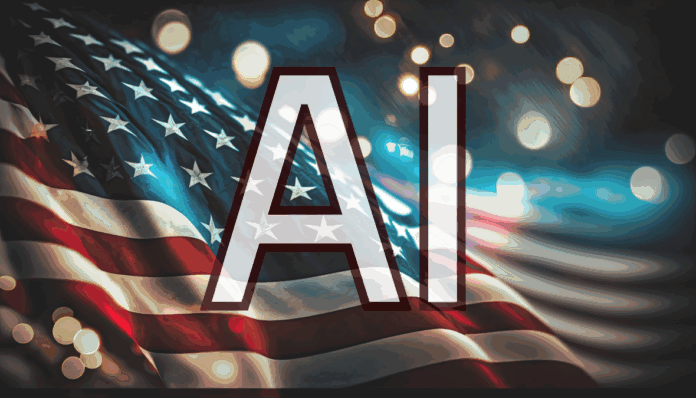What’s in? Federal support for domestic AI tech and data center projects. What’s out? Any regulations that “unnecessarily hinder” AI, and LLMs that factor DEI into responses.
In sum – what you need to know:
AI action framework: The 23-page report lays out the Trump administration’s priorities for the domestic use and expert of artificial intelligence technologies.
Priorities and power: The report recommends actions on repealing regulation of AI, indirect influence on states’ AI regulations, speeding up permitting and review of AI infrastructure deployment and a rapid ramp-up of a program to support the export and promotion of American-made AI hardware, models, services, and applications.
Guardrails gone: The action plan places few limits on AI development, encouraging a “try-first” attitude for adoption and declares the importance of tech dominance in AI.
The Trump administration has released a 23-page federal AI Action Plan that is aimed at speeding up artificial intelligence infrastructure deployment, limiting regulation of AI and promoting export of an American AI technology stack, while prohibiting federal procurement of artificial intelligence models that generate “biased AI outputs driven by ideologies like diversity, equity, and inclusion (DEI) at the cost of accuracy.”
President Donald Trump signed a series of executive orders yesterday, one for each aspect of the plan.
“The United States must not only lead in developing general-purpose and frontier AI capabilities, but also ensure that American AI technologies, standards, and governance models are adopted worldwide to strengthen relationships with our allies and secure our continued technological dominance,” the White House said in materials related to the executive orders.
“Whoever has the largest AI ecosystem will set global AI standards and reap broad economic and military benefits. Just like we won the space race, it is imperative that the United States and its allies win this race,” authors Michael Kratsios, assistant to the president for science and technology; David Sacks, special advisor for AI and crypto, and Marco Rubio — identified as assistant to the president for national security affairs, rather than as secretary of state — in the introduction to the AI Action Plan.
The details of the executive orders included:
-Establishing a “coordinated national effort to support the American AI industry by promoting the export of full-stack American AI technology packages.” This includes an American AI Exports Program that must be up and running in 90 days to support the “development and deployment of United States full-stack AI export packages.”
-The order outlined “full-stack AI” as encompassing AI-optimized computer hardware like chips and servers, plus storage, networking and cloud services; data pipelines and labeling systems; AI models and systems; security measures; and AI applications for specific use cases.
-Designating Rubio as the lead on developing and executing a unified federal strategy for the export and promotion of American AI technology abroad — within the bounds of restrictions on technology exports.

-Promoting streamlined environmental reviews, promoting the use of federal lands — including brownfield and hazardous Superfund sites — for data center development to “[repurpose] these lands for productive use.”
-Promoting investment in American small businesses that are working on AI, through the Small Business Administration’s Office of Investment and Innovation.
-Ordering federal agency heads that they may only purchase LLMs that adhere to what the White House is calling “Unbiased AI Principles”. Those two principles were “truth-seeking” and “ideological neutrality.”
The order defined “truth-seeking” as LLMs that are “truthful and prioritize historical accuracy, scientific inquiry, and objectivity, and acknowledge uncertainty where reliable information is incomplete or contradictory”. It defined “ideological neutrality” as LLMs that are “neutral, nonpartisan tools that do not manipulate responses in favor of ideological dogmas like DEI, and that developers will not intentionally encode partisan or ideological judgments into an LLM’s outputs unless those judgments are prompted by or readily accessible to the end user.”
The Trump administration framed those conditions as “preventing woke AI in the federal government.”
AI Action Plan details on state regulations and more
The AI Action Plan itself takes a deliberately light hand with any limitations on AI, and orders a repeal of existing federal regulations or reexamination of legal decisions which “unnecessarily hinder” AI development or deployment.
“AI is far too important to smother in bureaucracy at this early stage, whether at the state or Federal level,” the plan says. “The Federal government should not allow AI-related Federal funding to be directed toward states with burdensome AI regulations that waste these funds, but should also not interfere with states’ rights to pass prudent laws that are not unduly restrictive to innovation.” However, the plan also directs that agency heads with federal funding for AI “limit funding if the state’s AI regulatory regimes may hinder the effectiveness of that funding or award.”
The AI Action Plan additionally directs the National Institute for Standards and Technology (NIST) to revamp with AI risk management framework to eliminate references to misinformation, DEI and climate change. It outlines promotion of a “try-first” AI climate for American businesses, directs federal agencies to prioritize AI skill development and investment in AI adoption, including in next-generation manufacturing to “usher in a new industrial renaissance” and in AI-enabled science and data sets; and drive adoption of AI within government, including in the Department of Defense.

In terms of infrastructure, the AI Action Plan recommends a number of actions related to streamlining environmental review and permitting, as well as advising that the current electrical grid be stabilized and optimized and that new, stable sources of power — specifically, enhanced geothermal, nuclear fission, and nuclear fusion — should be embraced to meet the power needs of AI data centers.
The plan also offers some high-level recommendations for cybersecurity and bio-security as it relates to AI, and countering the influence of China in global organizations such as the United Nations and the International Telecommunications Union.
In addition, the AI Action Plan also recommends that the U.S. tighten export controls on semiconductor manufacturing subsystems. It currently exerts trade controls on major chip systems, but not down to the subsystem level.
Reactions to the AI Action plan
The White House’s AI Action Plan received mixed reactions, with overall favorable reactions from industry observers on the infrastructure side of the orders, but some concerns about the near-complete lack of guardrails on AI.
“These priorities align closely with our own commitment to building a future where AI drives progress across every sector of the economy,” wrote John Roese, global CTO and chief AI officer at Dell Technologies, in a post on the plan. “The Action Plan’s emphasis on infrastructure, workforce development and innovation reflects the same priorities we’re advancing with our customers and partners across government and industry.”
He added that Dell’s work on AI helped to inform the plan, and called the federal action a “pivotal opportunity to turn vision into action,” adding, “We look forward to continuing our collaboration to implement an actionable AI roadmap.”
Navroop Sahdev, CEO of think tank The Digital Economist, which advocates for responsible AI, saw both pros and cons to the plan. “There are parts of the plan we can align with,” she wrote on LinkedIn. “Investments in workforce transformation, AI literacy, and scientific research signal that technology can and should empower people. The emphasis on AI adoption in critical sectors like healthcare and manufacturing is overdue. And the push to create open-source ecosystems and transparent AI evaluations could help build the trust AI so desperately needs.
“But let us be clear: America’s AI Action Plan is not neutral,” she added, with emphasis. “The wholesale removal of guardrails—such as ethical constraints around bias, misinformation, climate impact, and inclusion—risks creating a brittle and extractive AI landscape. Deregulation is framed as a patriotic act, but at what cost? … The plan’s vision of ‘objective’ AI dangerously ignores the fact that data is never neutral, and models reflect societal patterns—including discrimination and exclusion.”
She also pointed out that “The emphasis is on exporting U.S. tech—rather than co-creating interoperable, inclusive standards. … It assumes leadership through control, not collaboration. But sustainable leadership in the AI age will depend on legitimacy, not just leverage.”
The AI Action Plan is available to read here.

